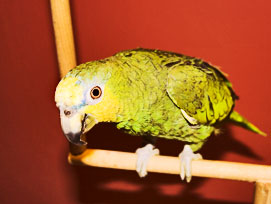
Amazons need plenty of toys. They are curious and intelligent creatures who will become destructive if left alone in their cages for long periods of time without anything to do.
Most amazons will enjoy swings and perches. You can buy them at a store or use natural perches, preferably made from manzanita, guava or other hard wood. Some parrot aficionados say that a cement perch can help keep the nails trimmed, but this should not be their primary roosting ground. The rough and hard material can hurt their feet.
Make sure there is adequate space between perches and swings, allowing them to jump from one to another. The perches should also be placed in such a way that the droppings won’t come in contact with food dishes or other toys.
Amazons like to have a good view, and usually want a “safe” high roost when they nap. Have a comfortable plastic or wooden perch or swing at the top of the cage.
Amazons are prolific chewers, so avoid any toys that have very fragile parts they can bite off and possibly choke on. Check the surface of the toys for sharp parts that can hurt their break or their face.
You will need a great many chew toys. Paper toys are great for shredding, while squeaky toys and noise toys can add an element of surprise—“hey, this thing make’s music each time I bite it!” Expect the toys to break down after a while, so inspect them regularly and replace as needed. As a general rule, look for toys made of untreated wood, acrylic, vegetable-tanned leather, and sisal.
Don’t put all the toys in the cage at the same time. They’ll take up too much space, and will quickly lose their novelty factor. Instead, give 3 toys at a time and replace with a new set every week. Rotating toys also makes it easier for you to clean and inspect them before putting them away. Be sure to clean all toys (especially those that have been chewed). Use a damp cloth and then dry thoroughly before storing.
Since Amazons can get destructive, you should observe the birds the first time they use a toy. You’ll be able to spot any possible choking hazards, and determine if the toy is strong enough to withstand the “abuse” it will get.
And finally, remember that all the toys in the world can’t substitute for daily “flying” time when the birds can explore the room. You can also get a bird gym, where they can play in open space with several toys at their disposal.